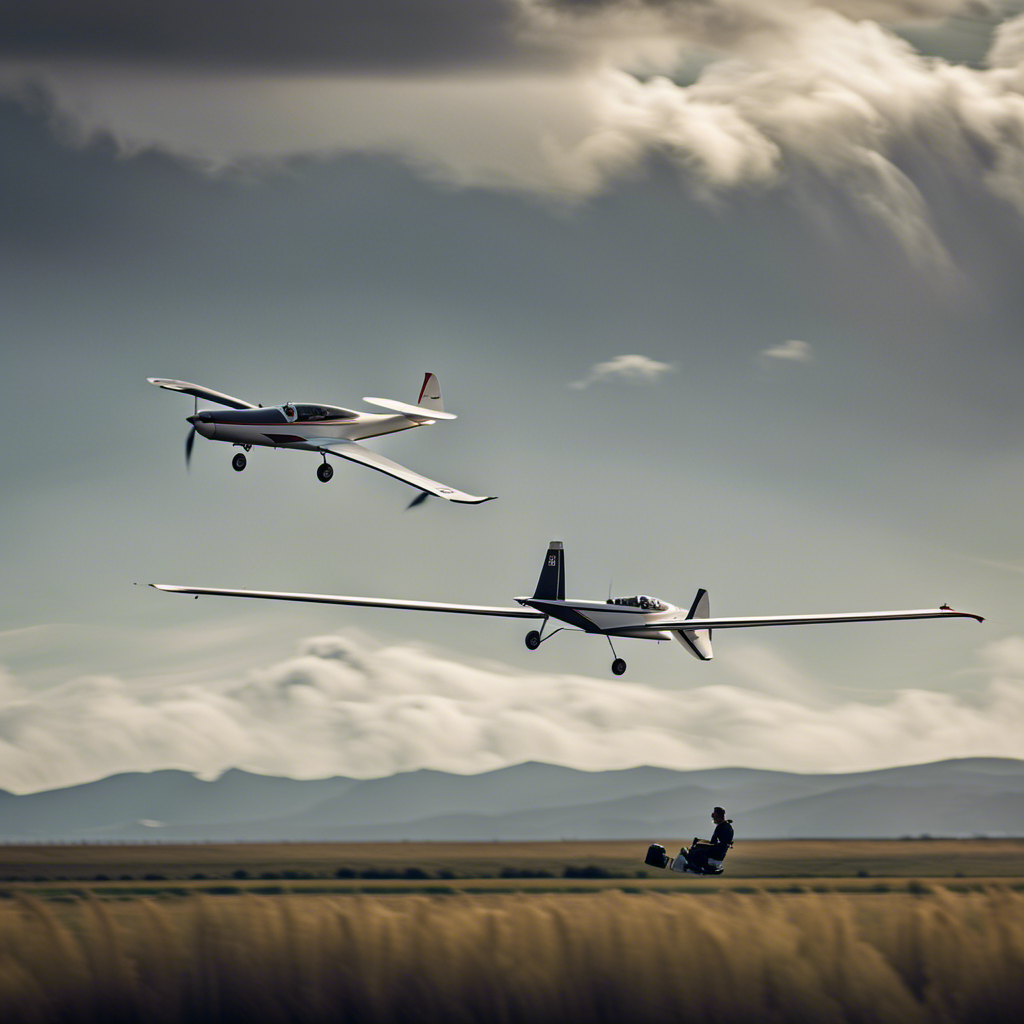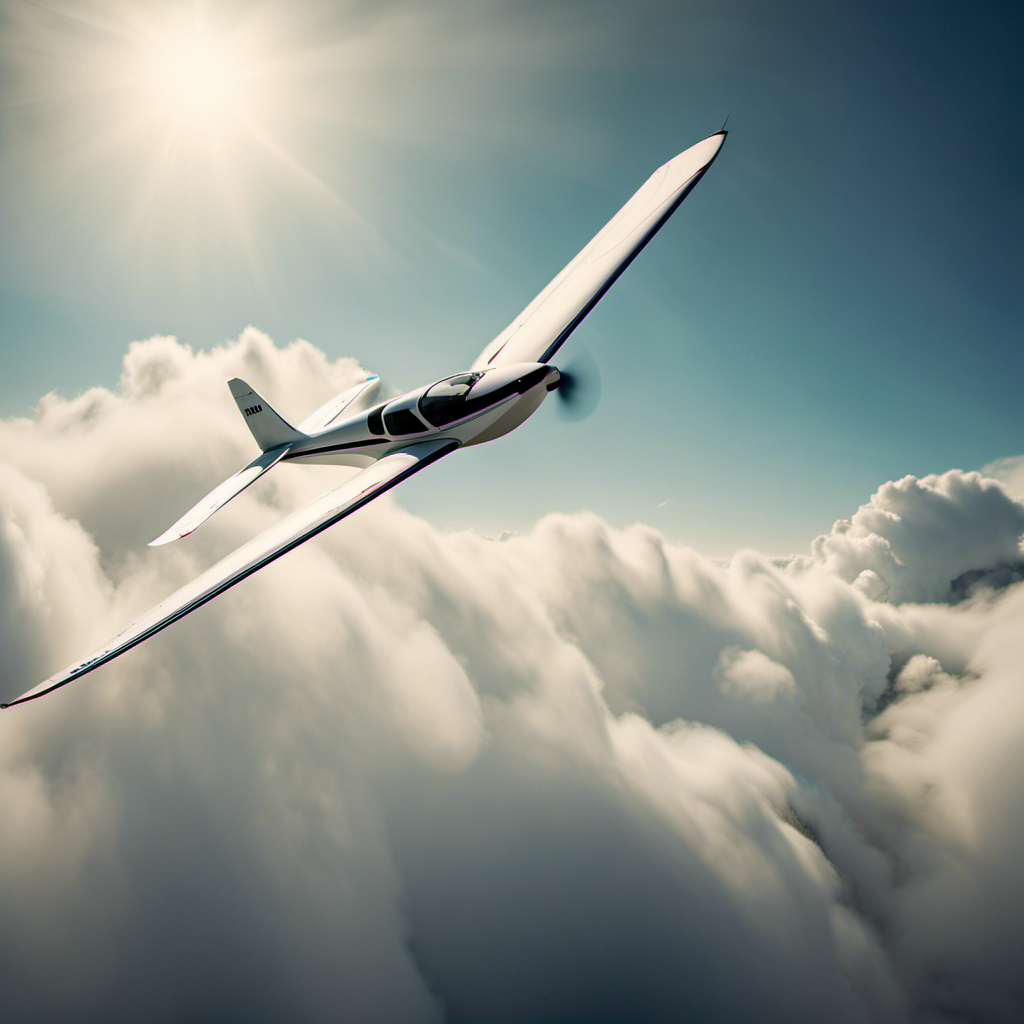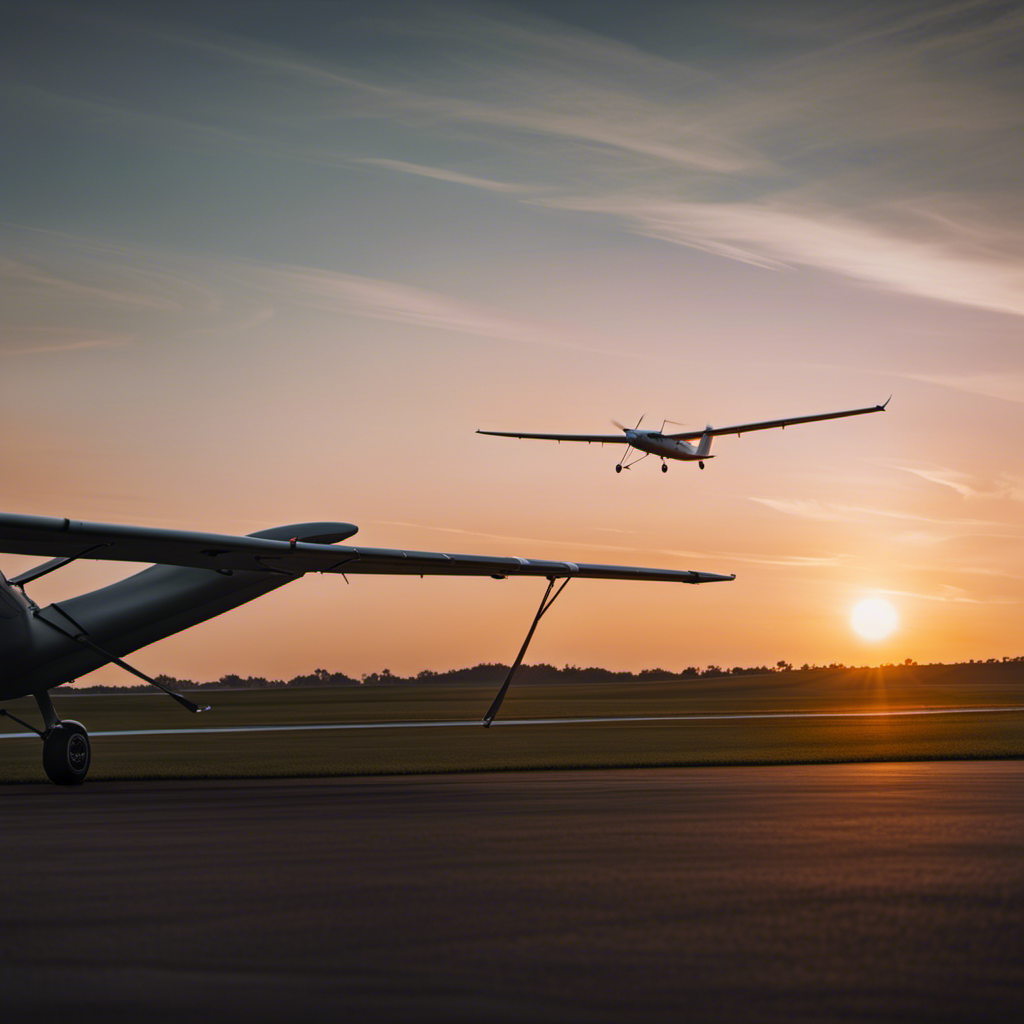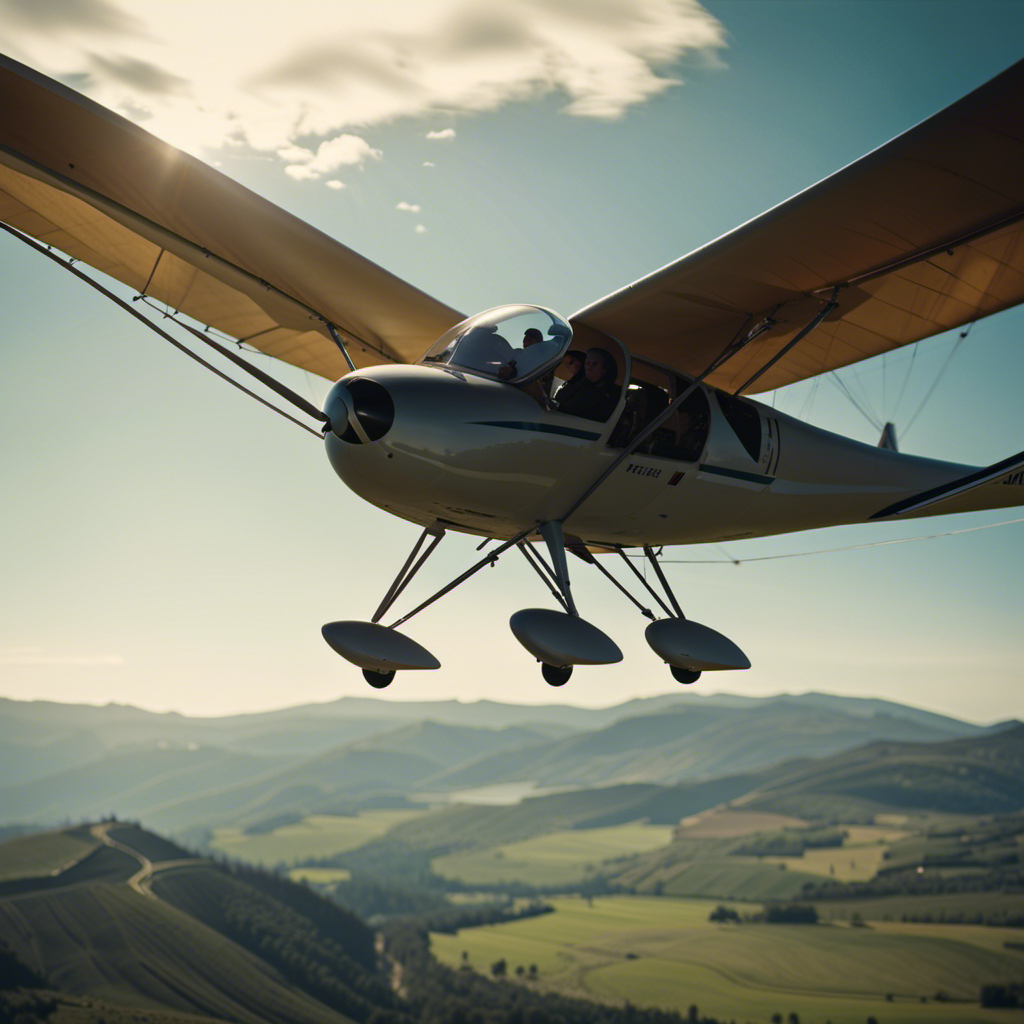Just like a skilled pilot navigating through the sky with expertise, you may be curious about the distinctions between aerotow and winch launch when it comes to gliding.
In this article, we will delve into the technical aspects of these two popular methods, exploring the equipment, safety considerations, training requirements, and performance variations.
By the end, you’ll have a clear understanding of these launch techniques, empowering you to make an informed decision about which method suits your soaring aspirations best.
Key Takeaways
- Aerotow launch involves using a powered aircraft to tow the glider into the air, while winch launch uses a ground-based winch to rapidly pull the glider into the air.
- Aerotow launches provide a controlled and gradual ascent, allowing for longer and higher initial climbs, increasing the chances of finding thermals or lift. Winch launches, on the other hand, are quick and efficient, providing a high-speed initial climb.
- Aerotow launches are ideal for training purposes and longer cross-country flights, while winch launches are possible in remote areas or smaller airfields and are less expensive than aerotows, making them an attractive option for gliding clubs on a tight budget.
- Winch launches require a suitable winch setup and launch location, are more susceptible to weather conditions, and require precise control and timing.
Glider Launch Methods: An Overview
Now, let’s take a look at the two main methods for launching gliders: aerotow and winch launch.
These methods are widely used in the gliding community and each has its own advantages and applications.
Aerotow launch involves using a powered aircraft to tow the glider into the air. It requires a specially designed tow rope that connects the glider to the towing aircraft. Once the glider reaches the desired altitude, it releases the tow rope and continues its flight independently.
This method allows for controlled and gradual ascent, making it ideal for training purposes and longer cross-country flights.
Now, let’s delve into the details of the aerotow launch and how it works.
Aerotow Launch: How It Works
During an aerotow launch, an aircraft is towed into the air by another aircraft using a long cable. This method is commonly used in glider operations and offers several advantages. Firstly, it allows for a more controlled ascent, as the pilot can release the tow cable at any desired altitude. Additionally, aerotow launches provide a longer and higher initial climb, which increases the glider’s chances of finding thermals or lift. To give you a clearer understanding of the differences between aerotow and winch launch, here is a comparison table:
| Aspect | Aerotow Launch | Winch Launch |
|---|---|---|
| Launch Speed | Higher | Lower |
| Altitude Reached | Higher | Lower |
| Launch Control | Pilot-controlled | Mechanically-controlled |
| Cable Length | Longer | Shorter |
As you can see, the aerotow launch offers a controlled ascent to higher altitudes compared to the winch launch.
Winch Launch: How It Differs from Aerotow
When launching with a ground-based winch, you’ll experience a different method compared to aerotow. The winch launch involves using a powerful winch attached to the glider to rapidly pull it into the air.
One advantage of this method is that it allows for quick and efficient launches, as the winch can generate high speeds.
However, a disadvantage is that the winch launch requires a suitable winch setup and may be limited by the availability of suitable launch locations.
Launching with a Ground-Based Winch
To launch with a ground-based winch, you’ll need a strong cable and a capable winch driver. The cable must be able to withstand the tension and forces involved in the launch, ensuring a safe and successful takeoff.
The winch driver plays a crucial role in controlling the winch and maintaining the appropriate tension on the cable throughout the launch. With precise control and timing, the winch driver can provide the necessary force to accelerate the glider to the desired speed for takeoff.
However, launching with a winch does have its own set of advantages and disadvantages. It allows for launches in areas where aerotow may not be possible or practical, such as in remote locations or on smaller airfields. On the other hand, winch launches can be more challenging to execute due to the quick acceleration and higher workload on the pilot.
Advantages and Disadvantages
You can weigh the pros and cons of using a ground-based winch for launching, considering factors such as location limitations and the increased workload on the pilot.
-
Location limitations: Using a winch requires a suitable location with enough space for the winch vehicle and a clear runway for the glider. This can be challenging in areas with limited open space or uneven terrain.
-
Increased workload on the pilot: With a winch launch, the pilot has to manage the glider’s pitch attitude during the rapid initial climb, which demands more attention and skill compared to an aerotow.
-
Cost-effectiveness: Winch launches are generally less expensive than aerotows, making them an attractive option for gliding clubs on a tight budget.
-
Weather conditions: Winch launches are more susceptible to weather conditions, such as strong winds or gusts, which can affect the launch and make it less safe.
Considering these factors, it is important to carefully evaluate whether a ground-based winch launch is the best choice for your specific situation. However, before making a decision, it is crucial to also consider equipment and safety considerations.
Equipment and Safety Considerations
When it comes to glider and towing equipment, there are several key points to keep in mind for safety and efficiency.
First, it is essential to ensure that the glider and tow equipment are in proper working order before each flight. Regular maintenance and inspections are crucial to prevent any potential issues during towing.
Additionally, following safety procedures and taking necessary precautions, such as proper weight distribution and communication with the tow pilot, are essential for a successful and safe glider flight.
Glider and Towing Equipment
The glider’s performance depends on the type of towing equipment used. To ensure a successful glider launch, it is crucial to have the right equipment in place. Here are four key factors to consider:
-
Tow Rope: The tow rope should be strong and durable, capable of withstanding the forces exerted during the launch. It should also have minimal stretch to provide a consistent and smooth tow.
-
Tug Aircraft: The tug aircraft must have sufficient power to generate the necessary speed and altitude for a successful launch. It should be well-maintained and in optimal condition for safe towing.
-
Release Mechanism: The release mechanism is responsible for detaching the glider from the tow rope at the appropriate time. It should be reliable, easy to operate, and provide a smooth release to avoid any sudden jolts.
-
Towing Point: The towing point on the glider must be strong and secure to handle the forces exerted during the launch. It should be positioned correctly to ensure proper balance and stability.
By carefully considering these factors and using the right towing equipment, you can enhance the glider’s performance and ensure a safe and successful launch.
Now let’s delve into the crucial safety procedures and precautions to follow during the aerotow and winch launch.
Safety Procedures and Precautions
To ensure a safe and successful launch, it’s important to follow specific safety procedures and precautions. Before each launch, you should conduct a thorough pre-flight inspection of the glider and towing equipment. Check for any signs of damage or wear and ensure that all components are securely fastened.
It is crucial to communicate effectively with the tow pilot and ground crew, using clear hand signals or radio communication. Make sure that you are properly equipped with safety gear such as a helmet and harness.
Additionally, it is essential to understand and adhere to the regulations and guidelines set forth by the gliding association or governing body. By following these safety procedures and precautions, you can minimize the risks associated with glider launches and ensure a safe experience.
Transitioning into the subsequent section about ‘training and certification requirements,’ it is important to note that in order to participate in glider launches, pilots must meet specific training and certification standards.
Training and Certification Requirements
When it comes to pilot training for aerotow launch, you need to possess a solid understanding of aircraft handling and navigation techniques, as well as the ability to coordinate with a tow plane pilot.
Additionally, you will need to undergo specific training to ensure you are proficient in the procedures and safety precautions associated with aerotow launches.
On the other hand, for winch launch, skills and certification revolve around mastering the art of launching a glider using a powerful winch system, which requires precise timing, control, and the ability to handle sudden changes in acceleration.
Certification for winch launch involves demonstrating your proficiency in these skills through both written exams and practical flight tests.
Pilot Training for Aerotow Launch
For aerotow launches, you’ll need to receive proper training to learn how to handle the aircraft during takeoff and release. This type of launch involves being towed into the air by another aircraft, so it’s important to know how to coordinate with the tow plane and maintain control during the entire process. Here are some key aspects of pilot training for aerotow launch:
- Familiarization with the tow plane and its equipment
- Communication techniques with the tow pilot
- Techniques for releasing the towline safely
- Emergency procedures in case of a towline failure
Mastering these skills is crucial to ensure a smooth and safe aerotow launch.
Now, let’s move on to the skills and certification required for winch launch, which is another popular method of launching gliders.
Skills and Certification for Winch Launch
Now that you have gained the necessary skills and certifications for aerotow launches, it is time to dive into the world of winch launches.
Unlike aerotow launches where you rely on a powered aircraft to tow you into the air, winch launches use a powerful winch attached to the ground to launch gliders.
To successfully execute a winch launch, you need to possess a different set of skills. You must be able to handle the rapid acceleration and strong forces experienced during the launch. Additionally, you need to be aware of the cable and its potential hazards. It is crucial to understand the procedures for releasing the cable and how to react in case of an emergency.
With the right training and expertise, you will be ready to master the art of winch launches.
Transitioning into the subsequent section about the ‘cost comparison: aerotow vs. winch launch,’ it is important to consider the financial aspects of these two launch methods.
Cost Comparison: Aerotow vs. Winch Launch
The cost difference between aerotow and winch launch is significant. When considering which method to use for launching a glider, it’s important to take into account the financial implications. Here are four key points to consider:
-
Equipment costs: Aerotow requires a towplane, which can be expensive to purchase and maintain. Winch launch, on the other hand, requires a winch and a tow cable, which are generally more affordable.
-
Fuel costs: Aerotow relies on the towplane’s engine, which consumes aviation fuel. This can add up, especially for longer flights. Winch launch, on the other hand, does not require fuel, making it a more cost-effective option in terms of ongoing expenses.
-
Maintenance costs: Aerotow operations involve maintaining both the glider and the towplane, which can be costly. Winch launch operations, on the other hand, primarily focus on maintaining the winch, which is typically less expensive.
-
Operational costs: Aerotow often requires the use of an airport, which may involve landing fees and other costs. Winch launch can be performed in more remote locations, minimizing operational expenses.
Considering these cost factors can help you make an informed decision about which method to choose for launching your glider.
Now, let’s explore the performance and altitude differences between aerotow and winch launch.
Performance and Altitude Differences
When it comes to glider performance, launch altitude and climb rate play a crucial role. The altitude at which you launch your glider and the rate at which it climbs can greatly impact its overall performance in terms of speed, endurance, and maneuverability.
Higher launch altitudes typically result in longer flight times and the ability to reach greater distances, while faster climb rates allow for quicker ascents and more time spent soaring at higher altitudes.
Understanding the relationship between launch altitude, climb rate, and glider performance is essential for maximizing your flying experience.
Launch Altitude and Climb Rate
During an aerotow launch, the glider is connected to a towplane with a towline, and the towplane takes the glider to a certain altitude before releasing it. The typical altitude reached during an aerotow launch is around 2,000 to 3,000 feet above ground level (AGL). This altitude provides the glider with enough altitude to safely maneuver and find thermals for lift.
The climb rate during an aerotow launch can vary depending on the towplane’s power and the glider’s weight. Generally, the climb rate is around 500 to 1,000 feet per minute. It is important to note that the altitude and climb rate can be adjusted based on weather conditions and the specific needs of the glider pilot.
This altitude and climb rate have a significant impact on glider performance and enable the glider to reach higher altitudes for cross-country flights.
Impact on Glider Performance
Now that you understand the difference in launch altitude and climb rate between aerotow and winch launch, let’s explore the impact these methods have on glider performance.
When it comes to aerotow, the initial pull from the towplane allows for a smooth and controlled ascent, resulting in a steady climb rate. This gradual increase in altitude provides the glider with ample time to gain energy and gather speed.
On the other hand, winch launch involves a rapid acceleration from the winch, producing a more aggressive climb rate. This quick ascent can generate a higher initial speed for the glider, potentially leading to a more dynamic flight.
Imagine the glider gracefully soaring through the sky, harnessing the energy gained from the aerotow to maintain a steady glide. Now, picture the glider being launched with a winch, rapidly climbing to altitude and soaring with an exhilarating speed.
With the understanding of the impact these launch methods have on glider performance, let’s delve into popular glider clubs and schools that offer these experiences.
Popular Glider Clubs and Schools
When it comes to glider clubs and schools, there are two main types that you should be aware of: aerotow-focused and winch launch-focused.
Aerotow-focused clubs and schools primarily use a powered aircraft to tow the glider into the air, providing a smooth and controlled ascent.
On the other hand, winch launch-focused clubs and schools rely on a powerful winch to rapidly launch the glider into the air, making for a more dynamic and exhilarating experience.
Both types have their advantages and it’s important to consider which type aligns better with your preferences and goals in gliding.
Aerotow-Focused Clubs and Schools
Some clubs and schools primarily focus on aerotow for launching gliders. In aerotow launch, a powered aircraft tows the glider into the air using a towline. This method allows for a controlled ascent and the ability to reach higher altitudes. Aerotow-focused clubs and schools often have a fleet of towplanes and experienced pilots who specialize in towing gliders. They emphasize the importance of proper towline management, communication between the towplane and the glider, and safe release procedures.
The aerotow launch provides a smooth and steady ascent, allowing glider pilots to gain altitude and explore different soaring conditions.
Now, let’s move on to winch launch-focused clubs and schools, where a different launching technique is utilized.
Winch Launch-Focused Clubs and Schools
Winch launch-focused clubs and schools utilize a different technique to launch gliders into the air. Instead of relying on an aerotow, they use a winch, which is a device that rapidly unwinds a cable to launch the glider.
This method offers its own set of advantages and considerations:
-
Advantages:
-
Cost-effective: Winch launches are generally less expensive than aerotows, making it a more affordable option for glider pilots.
-
Flexibility: Due to the smaller infrastructure required, winch launch-focused clubs and schools can operate in more remote areas.
-
Considerations:
-
Limited altitude: Winch launches typically provide shorter initial climb rates and lower altitudes compared to aerotows.
-
Skill requirements: Pilots must be well-trained in winch launch techniques and be able to manage the potential challenges associated with the rapid acceleration.
Considering the different launch methods available allows you to weigh the pros and cons and make an informed decision based on your personal preferences and the specific requirements of your gliding activities.
Personal Preferences and Choosing the Right Method
Although both methods have their advantages, it ultimately comes down to personal preference when choosing between aerotow and winch launch. Aerotow involves being towed into the air by a powered aircraft, while winch launch uses a high-powered winch to rapidly reel in a cable attached to the glider. To help you make an informed decision, consider the following factors:
| Factors to Consider | Aerotow Launch | Winch Launch |
|---|---|---|
| Cost | Higher | Lower |
| Altitude | Greater | Lower |
| Speed | Slower | Faster |
In terms of cost, aerotow launches tend to be more expensive as they require the use of a powered aircraft. However, if you prefer to reach greater altitudes, aerotow is the way to go. On the other hand, if speed is your priority, a winch launch will get you off the ground faster. Ultimately, the choice between aerotow and winch launch depends on your personal preferences and what you value most in a glider launch.
Transitioning into the subsequent section: In conclusion, exploring the world of glider launches opens up a whole new realm of possibilities for aviation enthusiasts.
Conclusion: Exploring the World of Glider Launches
To wrap up, you’ve now gained a deeper understanding of the world of glider launches and the factors to consider when choosing the right method for you.
Glider launches can be achieved through two main methods – aerotow and winch launch. Both methods have their own advantages and considerations.
Aerotow launches involve a powered aircraft towing the glider using a tow rope, allowing for controlled ascent and longer flight durations.
On the other hand, winch launches rely on a ground-based winch system that rapidly pulls the glider into the air using a cable. This method offers a more cost-effective option and is suitable for shorter flights.
It’s important to consider factors such as cost, availability, personal preferences, and flight objectives when choosing the method that best suits your needs.
Frequently Asked Questions
Are there any other launch methods for gliders besides aerotow and winch launch?
Yes, there are other launch methods for gliders besides aerotow and winch launch. Some alternative methods include auto-tow, bungee launch, and self-launch using a motorized propeller. Each method has its own advantages and considerations.
Can a glider be launched using both aerotow and winch launch methods?
Yes, a glider can be launched using both aerotow and winch launch methods. Aerotow involves a powered aircraft towing the glider to altitude, while winch launch uses a stationary winch to rapidly reel in a cable and launch the glider.
What are the advantages and disadvantages of using aerotow over winch launch?
One interesting statistic to consider is that aerotow is the most common method of launching gliders. Advantages of aerotow over winch launch include higher altitudes and longer flights, but it can be more expensive.
Are there any specific safety considerations unique to aerotow or winch launch?
When it comes to safety considerations, both aerotow and winch launch have their own unique factors to consider. In aerotow, the risk of mid-air collisions and the need for proper communication with the tow plane are important. In winch launch, the potential for cable breakage and the need for proper cable handling are key safety concerns.
Can the choice between aerotow and winch launch affect the performance and altitude capabilities of a glider?
The choice between aerotow and winch launch can indeed affect the performance and altitude capabilities of a glider. Each method has its advantages and limitations, which can impact the glider’s climb rate, launch altitude, and overall flight characteristics.
Conclusion
So there you have it, a comprehensive overview of the difference between aerotow and winch launch methods for gliders. Both methods have their advantages and considerations, and it ultimately comes down to personal preference and the specific requirements of each flight.
However, it’s worth noting that according to a recent survey conducted by the International Gliding Commission, approximately 70% of glider pilots prefer aerotow launches due to the smoother and more controlled ascent. This statistic highlights the popularity and effectiveness of aerotow launches in the gliding community.
Remember, when choosing the right launch method, always prioritize safety and adhere to training and certification requirements.
Happy gliding!
With a heart that soars as high as the skies, Aria, affectionately known as “Skylark,” is the driving force behind Soaring Skyways. Her journey into the gliding world began as a young dreamer gazing up at the soaring birds, yearning to experience the weightlessness and freedom they embodied. With years of experience both in the cockpit and behind the scenes, Aria’s commitment to the gliding community is unwavering.










